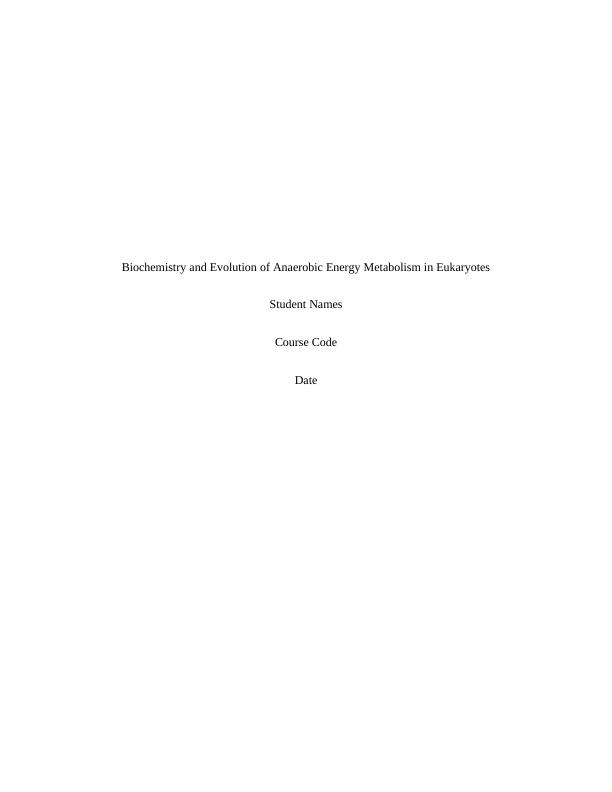Biochemistry and Evolution of Anaerobic Energy PDF
8 Pages1672 Words162 Views
Added on 2021-04-16
Biochemistry and Evolution of Anaerobic Energy PDF
Added on 2021-04-16
ShareRelated Documents
Biochemistry and Evolution of Anaerobic Energy Metabolism in Eukaryotes Student NamesCourse CodeDate

Introduction/AbstractInformation on whether mitochondria are present and function in eukaryotes living in anaerobic environments has been unclear[ CITATION Kar10 \l 1033 ]. However, documented research into the phylogenetic distribution, biochemistry, and evolutionary importance of organelles participating in the formation of ATP in eukaryotes which inhabit those conditions continues to increase in volume[ CITATION Rya16 \l 1033 ]. Anaerobic mitochondria function anaerobically and use compounds beside oxygen as the final electron acceptor[ CITATION Mik121 \l 1033 ]. The advances in the research have led to the conclusion that eukaryotic groups have an organelle with an origin unique to mitochondria, which has reproduced the origin of mitochondria to that of established eukaryotic groups[ CITATION Mik121 \l 1033 ]. The phylogeny of eukaryotic aerobes and anaerobes also interleaves around the eukaryotic groups’ diversity thereby disproving the belief that there exists a distinction between eukaryotic aerobes and their anaerobic counterparts[ CITATION Mik121 \l 1033 ].ExperimentationThe article selected documented research that has been previously done on the topic and links the findings to an updated phylogenetic framework. This is done to give a comparative picture that highlights the uniformity among mitochondrial energy metabolic pathways that are not dependent on oxygen among the many eukaryotic lineages without blurring any distinctions[ CITATION Tak14 \l 1033 ]. Therefore, findings on topics such as energy metabolism in anaerobic protists, hydrogenosomes, anaerobic mitochondria, Giardia intestinalis, Entamoeba histolytica, Trichomonas vaginalis and Tritrichomonas foetus were

covered[ CITATION Mik121 \l 1033 ]. The function of mitochondria in parasites was gathered from various articles and reference materials.Results and DiscussionSince the article was based on a review of previous research conducted in the field of anaerobic metabolism of eukaryotes, the findings presented comprised of systematic summaries of relevant knowledge. The information presented discussed the energy metabolism in anaerobic protists, hydrogenosomes, anaerobic mitochondria, Giardia intestinalis, Entamoeba histolytica, Trichomonas vaginalis and Tritrichomonas foetus, and function of mitochondria in parasites[ CITATION Mik121 \l 1033 ].Article CritiqueThe authors reviewed current biochemical information on enzymes and pathways taken by eukaryotes during anaerobic metabolism and identified the products that are generated in the anaerobic habitats (Müller, et al., 2012). Special attention was paid to the biochemical roles that the mitochondria in these organisms play in the anaerobic synthesis of ATP. The paper presents the metabolic maps of compartmentalized energy metabolism from 16 organisms (Müller, et al., 2012). However, the research does not report on any enzyme specialized in anaerobic metabolism, which are unique to any of the known six lineages of eukaryotes since genes found in a group are also present in another group (Müller, et al., 2012).This review was aimed at surveying the energy metabolism, particularly that of mitochondria in anaerobic eukaryotes in their life cycles. The study also focused on organisms such as metazoans, from which adequate biochemical information exists on the primary enzyme function, and the products excreted to facilitate the presentation of the metabolic maps (Müller,

End of preview
Want to access all the pages? Upload your documents or become a member.
Related Documents
Anaerobic Energy Assignment PDFlg...
|6
|336
|52
